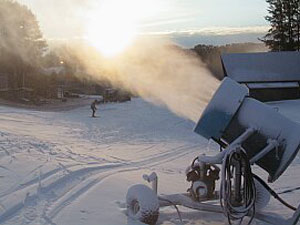|
Photos
Resources
Your Voice
|
Making Winter
January 20, 2003
 |
| Snowgun at Trollhaugen Ski Resort (skinnyski.com) |
St. Paul, Minn. — Making snow is a painstaking process. The water pressure has to be just right. Air has to hit the water with enough force to break it down into small enough droplets to begin the freezing process. And if it’s too warm or too humid, its not even worth trying.
"This is like farming," says Rusty Olson, who oversees snowmaking at Trollhaugen Resort in western Wisconsin. "You make hay when the sun shines, and its same for ski areas, when it’s cold, we make snow."
Olson has been making snow at Trollhaugen ski area for 22 years. He has 2 four-man crews, ready to turn water into snow around the clock if the conditions are right.
"Its a real labor intensive job," Olson said. "I mean, you're out there in below zero temperatures, you're working with 200 to 300 pounds of water pressure and you're also working with power in the cold and in the wet and everything else. Its hard to find people who can do this."
 | |||
Snowmaking is also resource intensive. Olson estimates Trollhaugen spends $10,000 a month on the electricity needed to run the snow guns. The resort also uses about 25,000,000 gallons of water a year to make snow. The water comes from a well on the ski area's property.
At the end of the season, the water returns to the ground as run-off. Some states in the east and west, where ski areas are bigger and water is not as plentiful, have started putting strict regulations on snowmaking.
In Minnesota, the Department of Natural Resources requires resorts that use more than a million gallons of water a year to have a special permit. The DNR's Jim Japs says the permits allow the agency to closely monitor snowmaking. "We haven't had any major issues come up in regards to snowmaking," he said. "We do have a number of conditions on our permits that would protect resources if a problem did develop. And we have the authority to suspend permits if there was a resource issue of concern." New technology is allowing resorts to make better snow, faster, and with less energy. Trollhaugen's Rusty Olson is testing out an automated snow gun for the first time this year and says he's started working towards full automation.
Cascade Mountain in central Wisconsin is the first Midwest ski area to automate snowmaking on a significant portion of its trails. Last year the ski area spent one point seven million dollars to automate a little more than 30 percent of it trails. Rob Walz leads cascade's snow making effort. He says threes a big difference in the type of snow he can make with the automated system.
"It takes the human guesswork out of it," Walz said. "Its where all snow making systems will be in the next 20 years. There won't be a single manual system out there."
 | |||
Walz says the investment in automation will pay off enormously in the long run. He's been able to cut back on labor costs and has reduced his energy consumption rate by 35 percent on the automated trails. And he says he hopes the better quality snow brings more skiers to the slopes more often.
Up until a few years ago, machine-made snow was reserved for downhill skiing. But a string of dry winters is forcing snowmobilers and nordic skiers onto the fake stuff too. The World Snowmobile Association, based in Maple Grove has started running races on machine-made snow at Canterbury Downs.
And at least three downhill resorts in the Twin Cities metro area now offer nordic skiing. Trollhaugen has the most extensive cross-country set up- a 1.6 kilometer course that is almost completely detached from the downhill area.
Nordic skiers like Dan Meyer say they're grateful to have the trail. "Its basically saving the winter for a lot of the high school teams," Meyer said. "If we didn't have this, we wouldn't be doing any skiing. So its quite nice."
But nordic skiers, snowmobilers, downhill skiiers and even the snow-makers like Rusty Olson all agree that even the best machine-made snow can't compete with a fresh pile-up of real flakes.
|
News Headlines
|
Related Subjects
|
